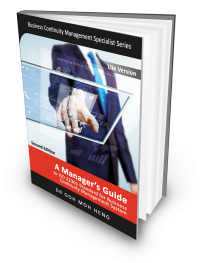Business Continuity Management (BCM): Difference between revisions
No edit summary |
No edit summary |
||
| (One intermediate revision by the same user not shown) | |||
| Line 12: | Line 12: | ||
<br>{{ORBoK 1: P1 Plan CL 1ORA}} | <br>{{ORBoK 1: P1 Plan CL 1ORA}} | ||
{{Template:BLCoursesBanner}} | {{Template:BLCoursesBanner}} | ||
{{Bcm Institute Source}} | {{Bcm Institute Source}} | ||
|} | |} | ||
{{Template:BCM Umbrella}} | |||
| | ||
<div class="thumb tright"> | <div class="thumb tright"> | ||
</div> | </div> | ||
[[File:Dr Goh Moh Heng WordPress Blog Compress.jpg|thumb|right|500px|Dr Goh Moh Heng WordPress Blog Compress.jpg]] | [[File:Dr Goh Moh Heng WordPress Blog Compress.jpg|thumb|right|500px|Dr Goh Moh Heng WordPress Blog Compress.jpg]] | ||
Latest revision as of 12:37, 21 January 2025


2. Holistic management process that identifies potential threats to and organization and the impacts to business operations those threats , if realized, might cause, and which provides a framework for building organizational resilience with the capability for an effective response that safeguards the interests of its key stakeholders, reputation, brand and value-creating activities.

(Source: ISO 22301:2012 – Societal Security – Business Continuity Management Systems - Requirements) - clause 3.4
3. Implementation and maintenance of business continuity.
(Source: AE/HSC/NCEMA 7000:2021)
4. A holistic management process that identifies potential impacts which threaten an organization and provides a framework for building organizational resilience with the capability for an effective response that safeguards the interests of its key stakeholders, reputation, brand and value-creating activities.
(Source: SS540 Singapore Standard on Business Continuity Management - SS 540:2008)
5. A holistic management process that identifies potential impacts which threaten an organization and provides a framework for building resilience and the capability for an effective response that safeguards the interests of its key stakeholders, reputation, brand and value creating activities.
(Source: British Standard BS25999-1:2006 Code of Practice for Business Continuity Management)
6. A holistic management process that identifies potential impacts that threaten an organization and provides a framework for building resilience with the capability for an effective response that safeguards the interests of its key stakeholders, reputation, brand and value creating activities.
(Source: Business Continuity Institute - BCI)
7. A holistic management process that identifies potential impacts that threaten an organisation and provides a framework for building resilience with the capability for an effective response that safeguards the interests of its key stakeholders, reputation, brand and value-creating activities. Also, the management of the overall programme through training, rehearsals, and reviews, to ensure the plan stays current and up to date.
(Source: ENISA - the European Network and Information Security Agency. BCM & Resilience Glossary)
8. Business Continuity Management provides for the availability of processes and resources in order to ensure the continued achievement of critical objectives.
(Source: HB 221:2004 Business Continuity Management)
8. Business continuity management provides for the availability of processes and resources in order to ensure the continued achievement of critical objectives.
(Source: Malaysia BCM Standard MS1970:2007)
9. Management process that safeguards the interests of its key stakeholders, reputation, brand and value-creating activities by identifying potential impacts that threaten the organization and provides a framework for building resilience and the capability for an effective response.
(Source: Australia. A Practitioner's Guide to Business Continuity Management HB292 - 2006 ) ]]


